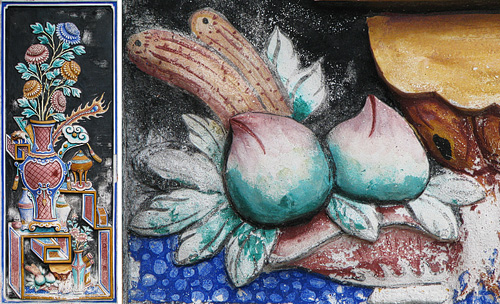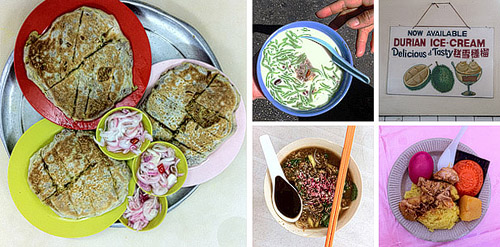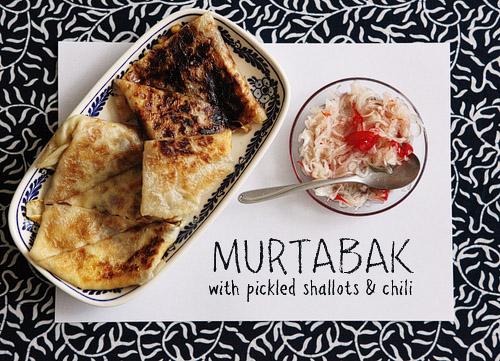From fried oysters to cendol, I consumed a number of delectables while travelling in Malaysia in late October. Our restaurants ranged from street food in Penang to a private beach BBQ on Redang Island. Malaysian food is an exciting blend of Indian, Chinese and Malay cuisines with regional curries and fried noodle courses. I tried a number of new dishes including sea cucumber and overly indulged a few old favorites, especially roti canai. One of the stand-out meals was in Penang at a small Indian restaurant consisting of a few varieties of murtabak (pictured below on the left) along with a table full of curries. Paired with the murtabak was a small bowl of thinly sliced, pickled red onion that brightened the dish and gave it a punch of flavour. This dish can be found in hawker markets around the city, mingling with an assortment of goods from beautiful batik prints to every tropical fruit imaginable.

The Khoo Kongsi is a Chinese clanhouse located in Penang, Malaysia originally built 1851. The building was burnt down in 1894 when it was allegedly struck by lightning and rebuilt in 1906. The Kongsi is elaborately decorated and is considered to be one of the most ornate temples in Malayisa. The exterior and interior of the walls are covered with carvings and murals, all used to convey messages and fortunes.
Murtabak is a stuffed roti that is fried and served with a curry sauce. Roti is a flat unleavened bread that is cooked upon a hot griddle. Murtabak is often stuffed with a mixture of egg, meat and vegetables and is cut into wedges. While experimenting with puff pastry for my next recipe, I had an unfortunate mishap and accidentally served it undercooked. It was Jon’s sister Faith, who remarked that it reminded her of chewy and buttery roti, which gave me the brilliant idea to use fried puff pastry as the roti in my adapted murtabak recipe. It yields a slightly different flavour – traditional roti is made with ghee – but provides the same texture and cuts the recipe time down from 1 ½ hours to about 20 minutes.

Murtabak
makes 4
4 sheets puff pastry
1 TB ghee
2 eggs, beaten
½ tsp salt
½ tsp ground pepper.
1 shallot, sliced
1 clove garlic, minced
1 tsp fresh ginger, minced
1 tsp tumeric
1 tsp garam masala
1 small radish, chopped
½ cup corn kernels
Heat the ghee in a pan and fry the shallot until soft. Add the garlic, ginger and radish and continue to fry for an additional 2-3 minutes. Add the turmeric, garam masala and corn kernels. Stir well.
Roll the puff pastry out on an oiled counter top as thin as possible (before holes begin to appear in the pastry). Cut in a large circle that is small enough to fit into your frying pan. Heat a frying pan on the maximum temperature on the stovetop and swirl around a tiny bit of ghee. Drape the rolled out puff pastry over the rolling pin and place on the hot frying pan. Quickly spoon over a ½ of a beaten egg and a quarter of the fried corn & radishes. Fold the sides of the pastry, like an envelope, to enclose the filling. Turn the murtabak to cook the side with the folded edges so that both sides are golden and crisp.
Serve hot with some pickled shallots and chilies (recipe below).

Quick Pickled Shallots & Chili
2 shallots
½ red chili
2 TB rice wine vinegar
1 tsp water
1 tsp brown sugar
Thinly slice the shallots and chili. In a small jar, mix the rice wine vinegar, water and brown sugar until the sugar granules have dissolved. Add the chili and shallots and stir to mix well. Place in fridge for at least 10 minutes. Keeps for 1 week in the refrigerator.

8 comments
Rosa says:
Nov 15, 2010
That dish looks fantastic!
Cheers,
Rosa
Julie says:
Nov 16, 2010
Your adventursome palate always amazes me.
deana says:
Nov 19, 2010
The name is vaguely familiar.. but I never knew what it was… great recipe and art work… how do you find these amazing things????
izzy says:
Nov 22, 2010
Murtabak is one of my favorite Indian dishes that I can hardly find outside of Singapore/Malaysia. Never actually had it with pickled shallots as I usually ask for a side of curry. Thanks for sharing.
Peggy says:
Nov 29, 2010
What a fantastic dish! Love your adaptations!
Megan Fizell (@tresjoliestudio) says:
Apr 29, 2011
All about Murtabak, a stuffed roti fried and served with a curry
sauce: http://ow.ly/4ItHa #recipe (via @MalaysiaKitchen)
Megan Fizell (@tresjoliestudio) (@tresjoliestudio) says:
Apr 29, 2011
All about Murtabak, a stuffed roti fried and served with a curry
sauce: http://ow.ly/4ItHa #recipe (via @MalaysiaKitchen)
Juliana Loh @bilbaobab says:
Jan 16, 2014
One dish I really miss about Singapore suppers! thanks for sharing the recipe! we never have them with pickled pickled shallots but it’s a great idea!